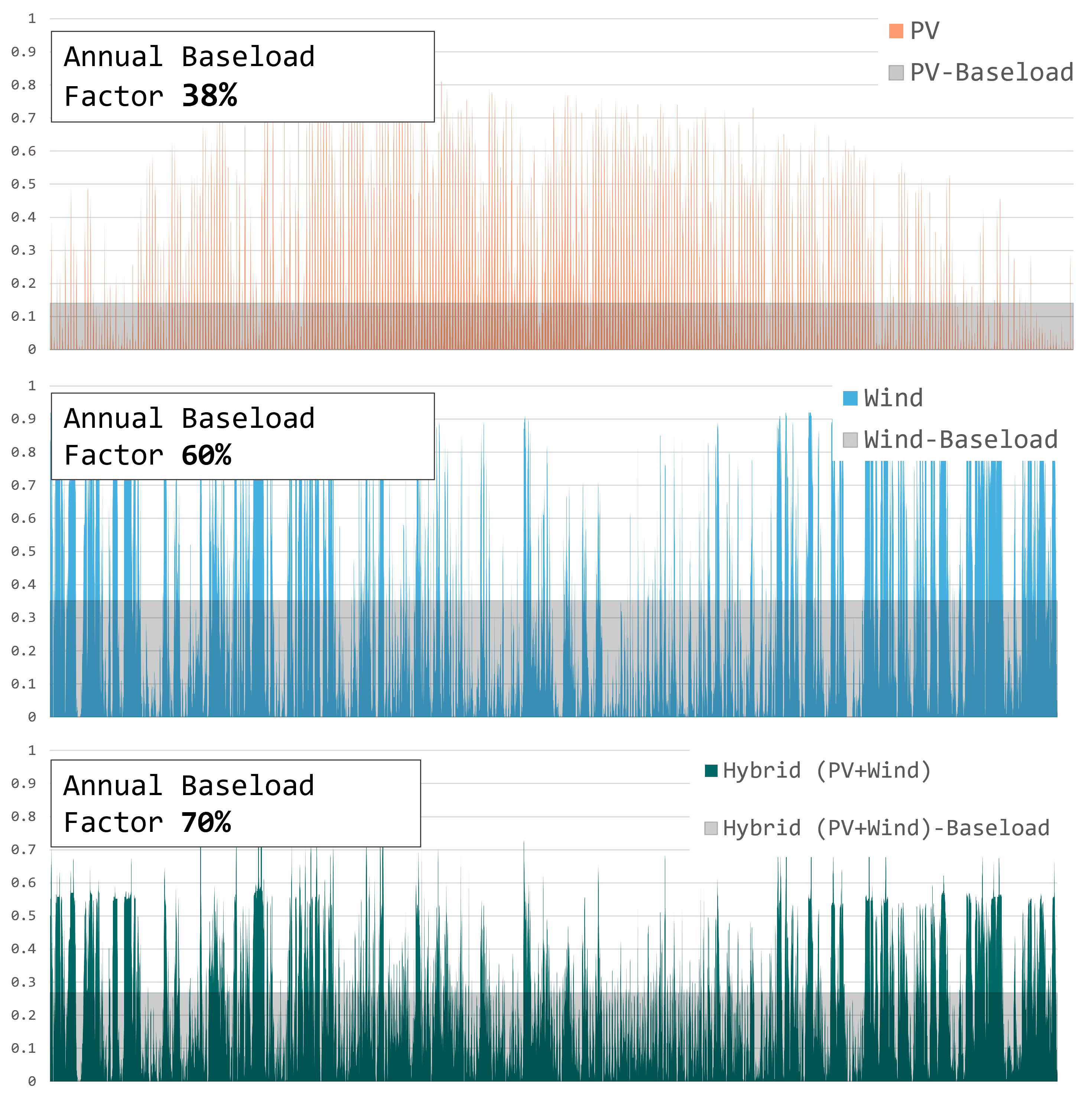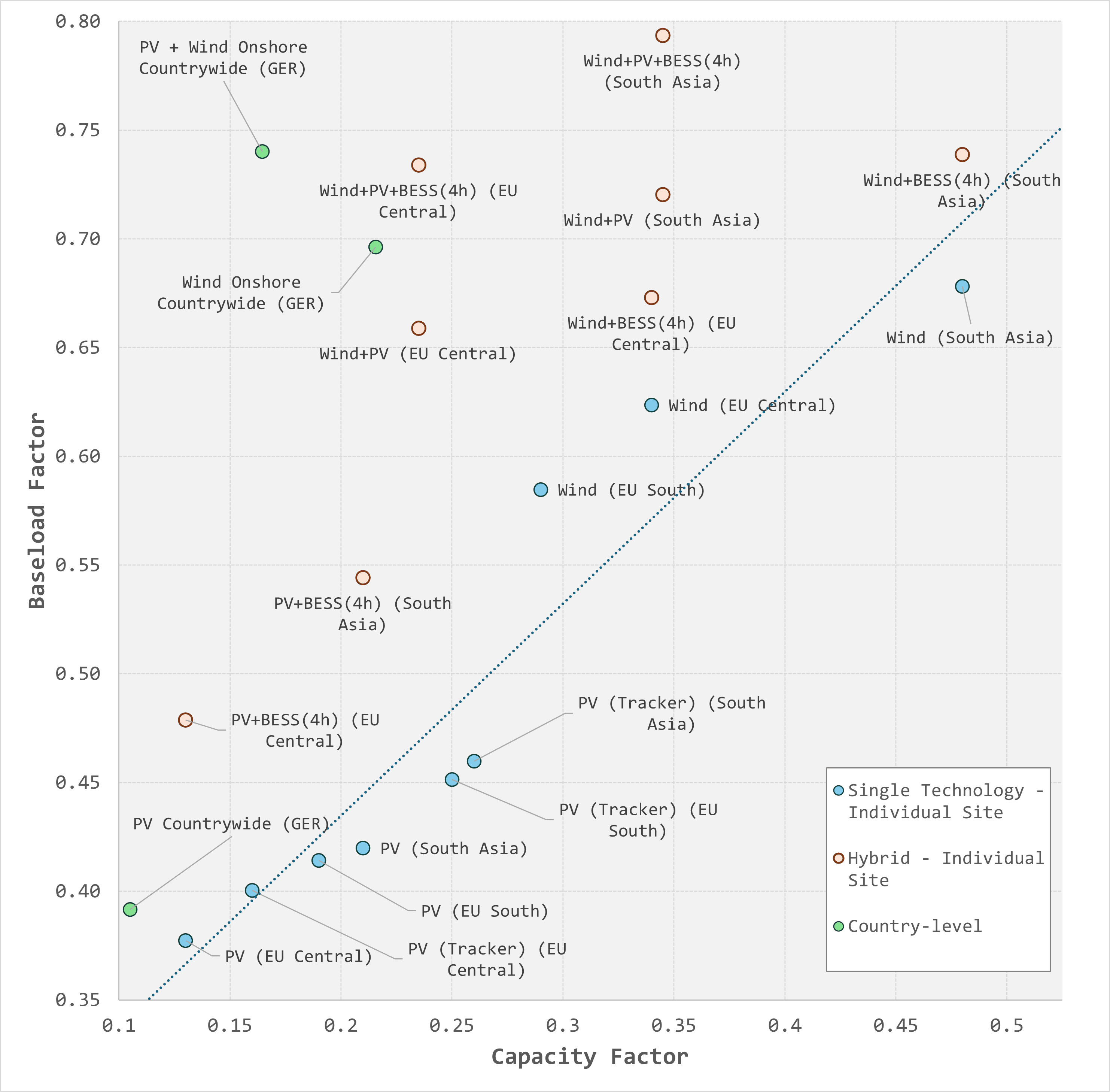Resources
The Baseload Factor:
Measuring Intermittency of Renewables
Published on August 14, 2025
Energy generated from solar and wind, although being among the cheapest sources of energy, faces the challenge of intermittency in its energy generation – especially when compared to conventional generation sources like coal or nuclear.
Intermittency, referring to the variability of renewable's energy production, is caused by the variability in the weather resource powering it's generation, wind in the case of wind energy and sunlight in the case of PV. Conversely, firmness refers to energy supply that is stable over time, with little to no variability.
Both intermittency and firmness are often discussed, especially in the context of hybrid and co-located projects, or those targeting round-the-clock (RTC) or 24/7 energy delivery – yet no formal measure exists to answer questions such as: How firm or intermittent are wind and solar? Is solar more intermittent than wind? How much less firm than conventional generation are renewables?
To fill this gap, we introduce the Baseload Factor.
What is the Baseload Factor?
The Baseload Factor is a measure of firmness, designed to calculate how much of a power plant's or portfolio's total energy production covers a firm baseload profile – as such, the Baseload Factor provides insights into the stability of energy output over time.
Definition of the Baseload Factor
The Baseload Factor (BF) is defined as the share of the total energy produced covering a baseload profile set to the average energy production.
Mathematically, it is defined as:
where is the energy production at timestamp , and is the coverage function
and is the average energy production:
Calculation of the Baseload Factor
The steps to calculate the Baseload Factor are as follows:
- Determine the average energy production
Calculate the average energy production per timestep (such as hourly) from the yearly (or multi-year) total production of the given power plant or portfolio.
- Construct a baseload profile
Create a baseload profile equal to the average energy production for each timestep.
- Calculate the coverage of the baseload profile
For each timestep, compute the coverage of the baseload profile, counting all production below or equal to the baseload profile and discarding any surplus.
- Normalize by the total energy produced
Divide the total energy covering the baseload profile by the total energy produced to determine the Baseload Factor.


Baseload Factor vs. Capacity Factor
The capacity factor, an often-used metric in the energy industry, measures the ratio of total energy produced in relation to its theoretical maximum possible output, its capacity. It allows for the comparison of the total power output of different projects regardless of their installed capacity.
Although at times mistakenly used as proxy for production stability or firmness, the capacity factor, unlike the Baseload Factor, targets the total energy production and does not differentiate between when that energy is produced. As such, it does not account for production variability, as low production at one point in time can be offset by higher production at a different time.
The limitations of the capacity factor in measuring firmness become apparent when evaluating hybrid projects or portfolios that combine multiple renewable sources, and / or storage technologies:
- Complementarity from Wind-PV-Hybrid: The production dynamics from wind and PV are often complementary, to varying degrees. Combining energy generation from a PV plant with that of a wind farm can therefore result in a more stable joint production profile. In terms of Baseload Factor, this would mean a higher value for the Wind-PV hybrid, as compared to that of the individual plants. Its joint capacity factor, however, will be the weighted average of the PV and wind farms.
- Portfolio Effects: Similarly, the Baseload Factor captures the increase in stability from combining projects in geographically dispersed portfolios of wind and PV, where differences in weather resources across locations can cause intermittencies to balance out to a large degree.
- Battery Energy Storage Systems (BESS): Adding BESS to PV to flatten its production by charging during the day and discharging at night, will result in a more stable power output in comparison to a standalone PV system, and a corresponding higher baseload factor. With total energy production remaning unchanged, or even slightly reduced due to battery losses, the capacity factor however will remain unchanged.
Looking at capacity factors and Baseload Factors for a sample of different renewable generation technologies and locations, we see that the Baseload Factor increases at a roughly linear relationship with the capacity factor for stand-alone wind and PV. The same is not the case for hybrid projects or portfolios: a wind-PV-hybrid plant in Central Europe can reach a Baseload Factor of roughly 66% at a capacity factor of 23.5%, much higher than a linear relationship would predict.
The most extreme divergences are for portfolios: The combination of all wind and PV plants in Germany reaches a Baseload Factor of 74% at a capacity factor of 16.5%!

Conclusion
With the share of renewable energy increasing in energy systems around the world, so do requirements to the energy generated – it is no longer sufficient to 'simply' produce, but to ensure that the energy produced adds value by meeting demand without adding additional burden to grid stability.
The need for more stable renewable energy generation can already be seen in the increase of hybrid, or co-located projects, the expansion of storage technologies, and the growing interest in 24/7 Power Purchase Agreements (PPAs). This shift illustrates a move away from the age where only the total production mattered, to a higher focus on production dynamics.
To address this, we introduce the Baseload Factor as a metric to quantify stability, to provide actionable insights to project design or site evaluation for developers, to guide incentives for policy-makers, and evaluate project value for investors.
To end with a quote from Qualenergia, the Italian energy industry news platform, from its article on the Baseload Factor:
"Its adoption would encourage hybrid plants, investments in energy storage, and policies that are more focused on the quality of energy, rewarding those who ensure not only how much energy is produced but, more importantly, when it is produced."
— Lorenzo Vallecchi, Qualenergia